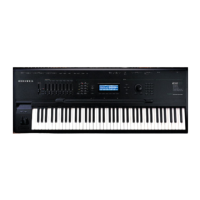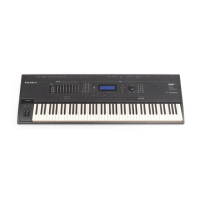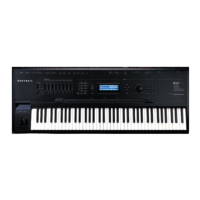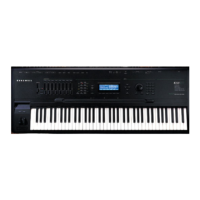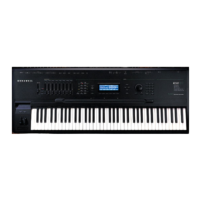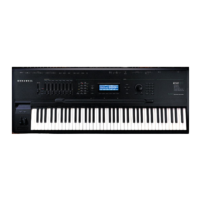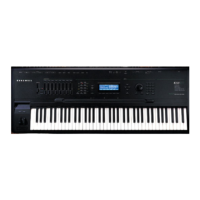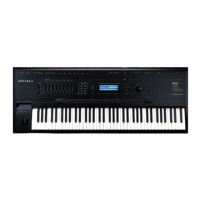DSP Functions
Waveforms
14-35
Waveforms
SINE
LOW FREQUENCY SINE
SAWTOOTH
LOW FREQUENCY SAWTOOTH
SQUARE
LOW FREQUENCY SQUARE
In this category of DSP functions are three standard synth waveforms—Sine, Sawtooth, and
Square—with high- and low-frequency variations of each. These are all one-stage functions.
They can be assigned in several different positions and combinations in many of the
algorithms.
One important fact to keep in mind is that assigning one of these waveforms to a layer’s
algorithm may remove the original sample from the signal, since they don’t have input signals
to send to their outputs (they send only the waveform that they generate themselves). If, for
example, you were editing the Acoustic Piano program, and you assigned SINE in the F1 block,
you would no longer hear the piano timbre, only the sine wave (unless the signal splits before
the F1 block, as in Algorithm 10). Consequently, you’ll tend to use these waveforms when you
want to build a sound from scratch. If you want to add a waveform to the original timbre of a
sound, use one of the added waveform functions described in the next section, or use one of the
split signal algorithms.
These waveforms can range in frequency from .1 Hz to 20 KHz. They’re not samples like the
instrumental sounds and other waveforms; they’re generated by oscillators. Since the DSP
function waveforms aren’t produced by playing back multi-sample keymaps, there are no
sample root transitions as you play notes in different keyboard ranges. This makes them
especially suitable for use with portamento and wide pitch bend ranges.
Since these waveform functions generate an output signal only, and don’t receive an input
signal to pass along, the algorithms are arranged so you won’t inadvertently assign a series of
waveforms that interfere with each other. You’ll usually find, for example, that if you can assign
a waveform in the F1 block, all subsequent blocks will allow you to assign only the added
waveforms. Or, if the subsequent blocks allow you to assign the “regular” waveforms, it’s
because the wiring of the algorithm is split so that the two waveforms pass through in parallel
(as in Algorithm 10).
This next point is a small one, but important, and may make it easier for you to understand the
way the waveform functions operate, especially if you’ve been carefully studying the wiring
paths of the algorithms. In several algorithms where the waveforms are available the wiring
paths of the algorithms (the horizontal arrows) appear to send a signal to an input of the
waveforms. This is not the case, and anywhere one of these waveforms is assigned, you should
view the algorithm as if there were no horizontal arrow pointing to the left (input) side of the
block where the waveform is assigned. The diagrams below will clarify this point. The only
difference in the DSP function assignments is in the F1 block, where the first and second
diagrams show the SAW waveform, and the third diagram shows the SAW+ added waveform
(described in the next section). In the first diagram, the PITCH function’s output (passing the
sample signal from the keymap) appears to be connected to the input of the F1 block (the SAW
function), as well as splitting and passing to the +GAIN function in the F2 block. This is what
you would see on the ALG page.
In fact, the actual signal path does not pass from the PITCH function through the SAW function;
it splits and bypasses the SAW function, as shown in the second diagram. The third diagram
shows the same algorithm with the SAW+ added waveform assigned to the F1 block. In this
case, the diagram is accurate; the signal passes from the output of the PITCH function, and
splits into a two-wire signal. The upper wire passes through the F1 block where the sawtooth
wave is added, and into the +GAIN function in the F2 block. The lower wire bypasses the F1
block, and passes directly to the F2 block, where it is combined with the upper wire signal.

